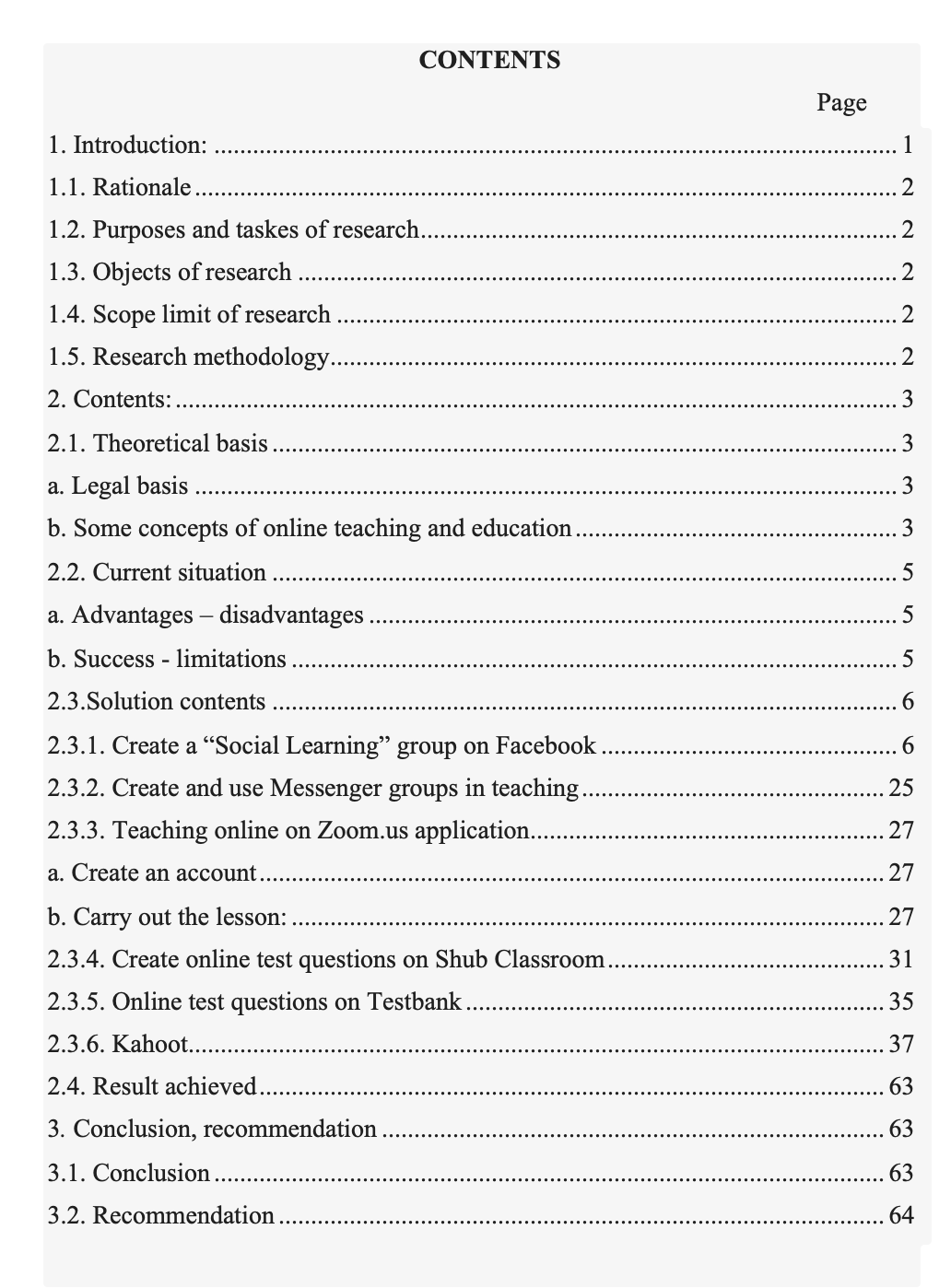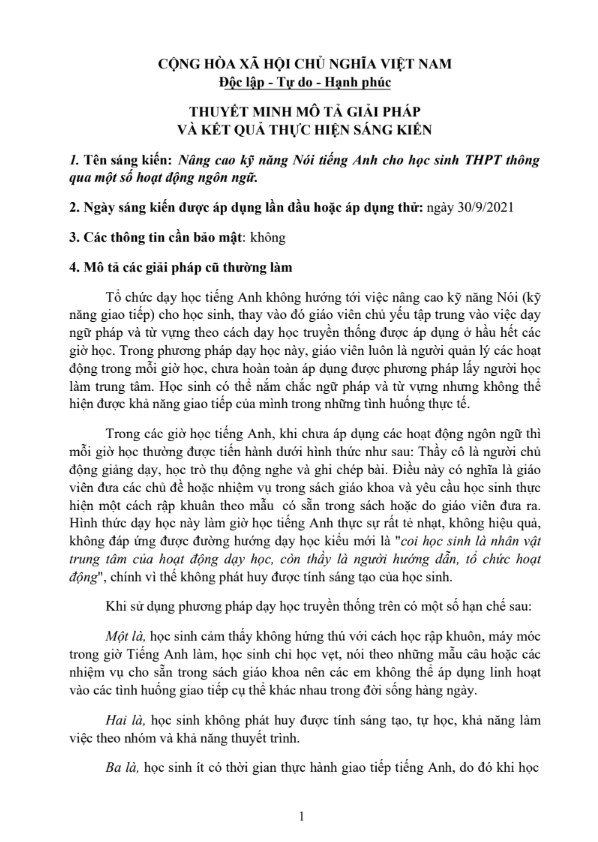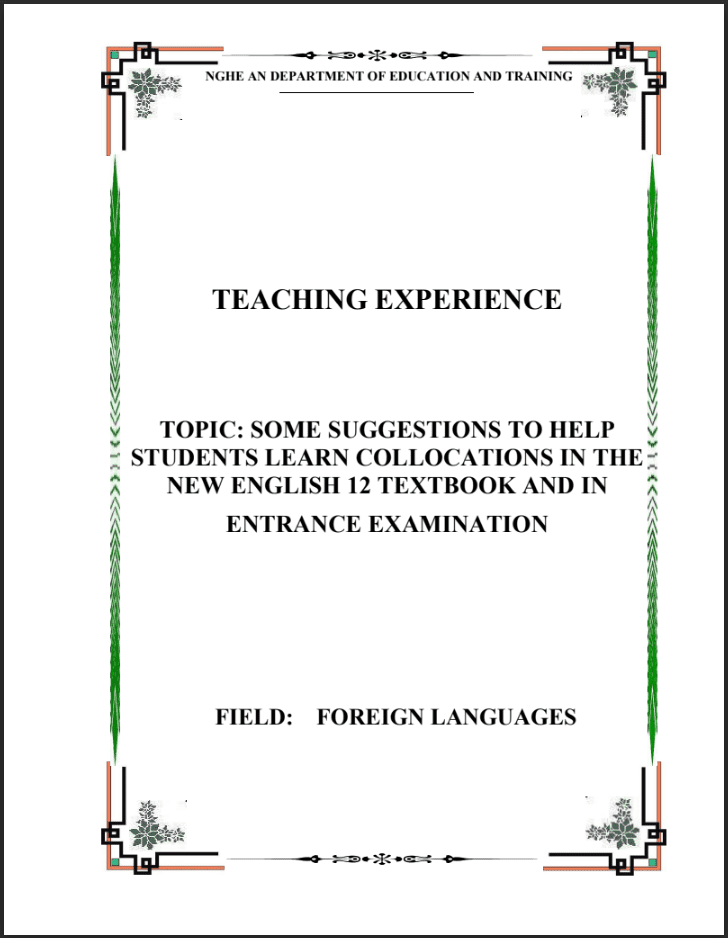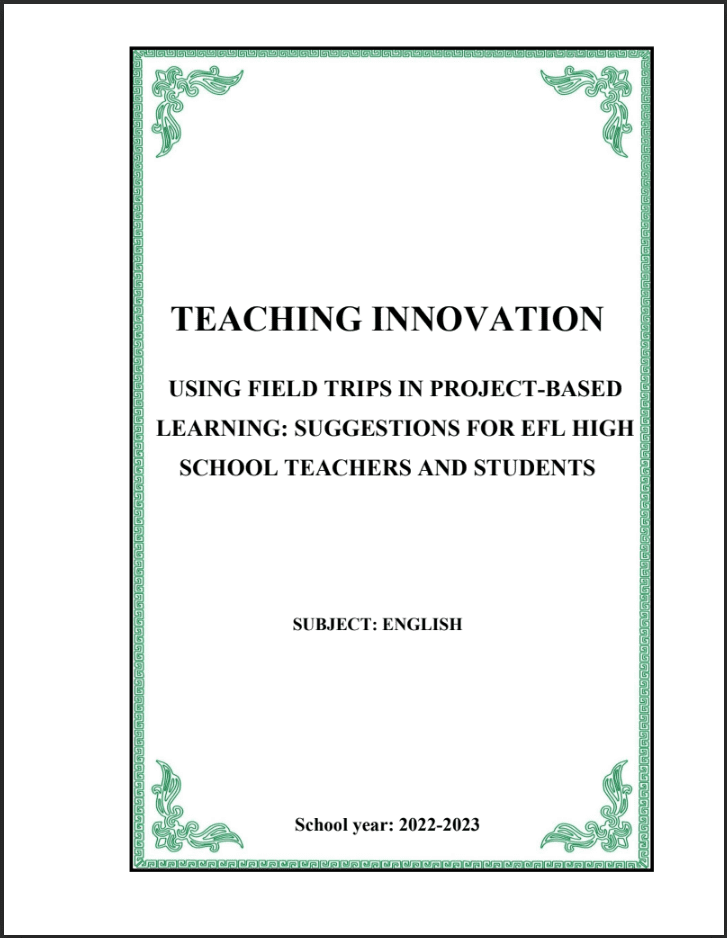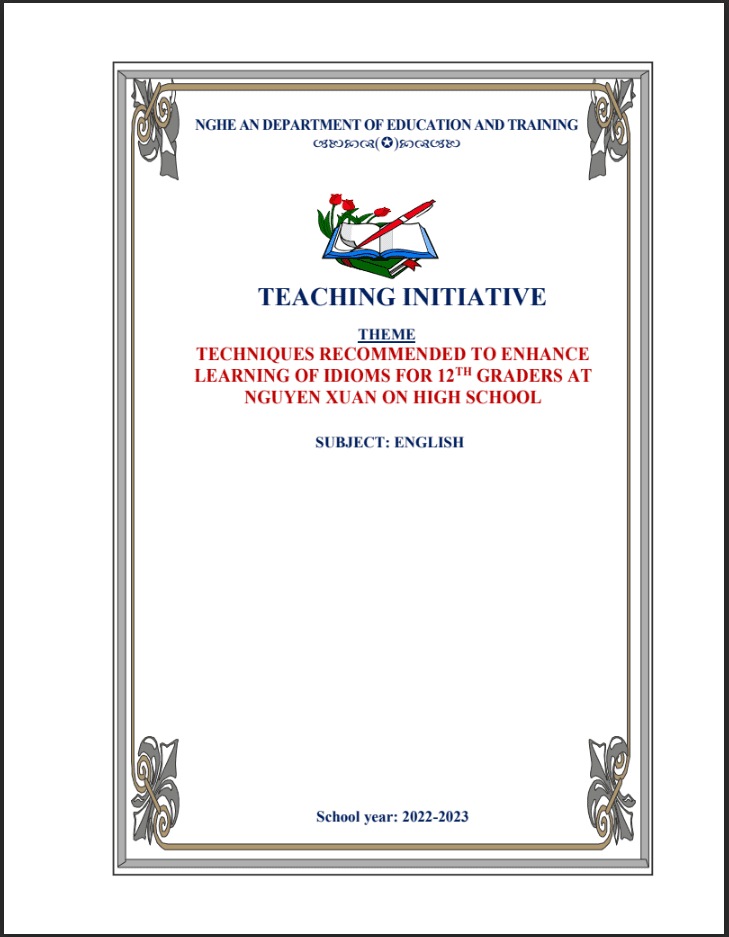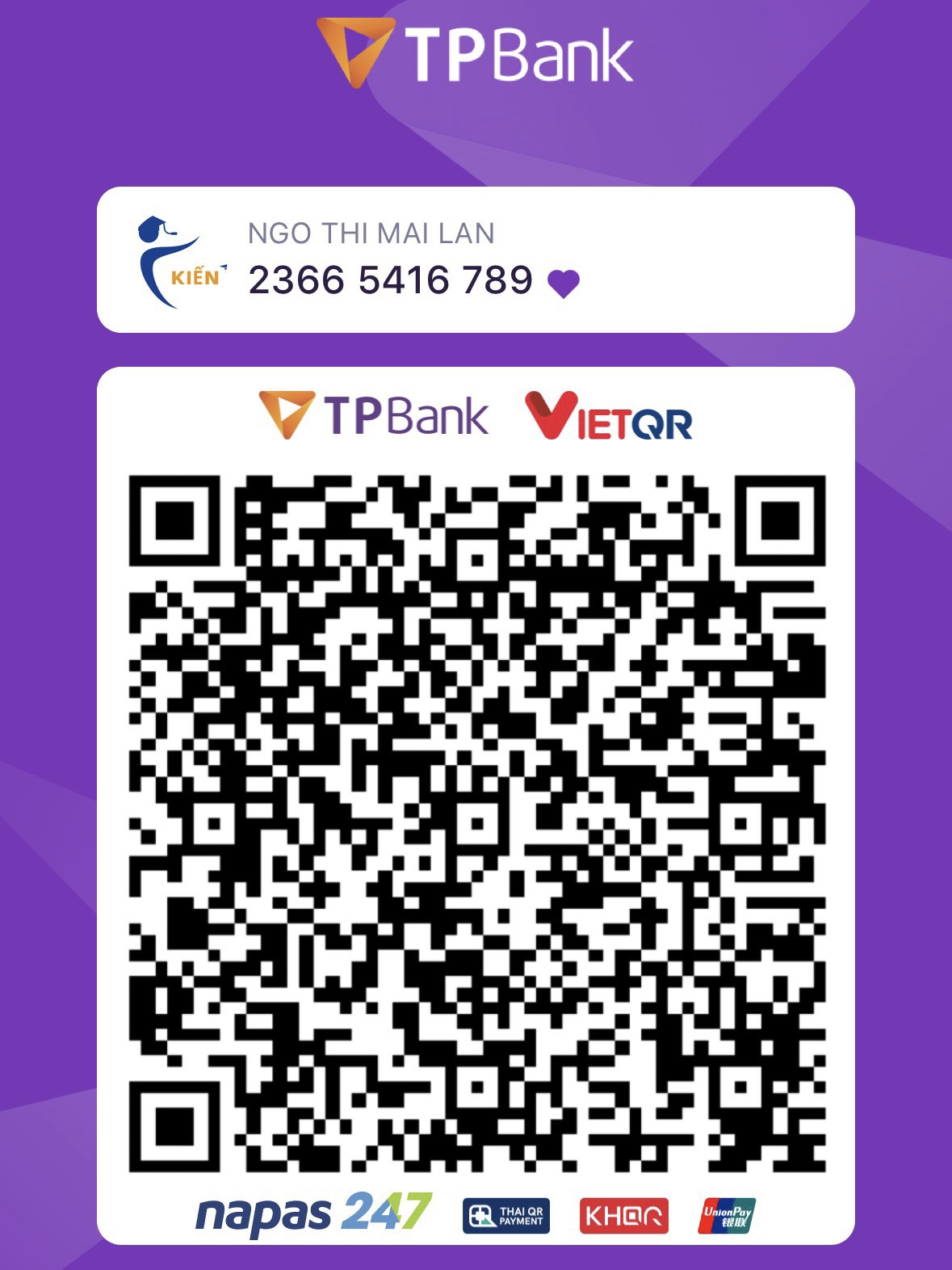SKKN Một số kỹ năng quản lý học sinh trong việc dạy học trực tuyến
- Mã tài liệu: MP0065 Copy
| Môn: | Tiếng anh |
| Lớp: | 10, 11, 12 |
| Bộ sách: | |
| Lượt xem: | 829 |
| Lượt tải: | 4 |
| Số trang: | 63 |
| Tác giả: | Bùi Thị Thanh Vân |
| Trình độ chuyên môn: | Thạc sĩ giáo dục |
| Đơn vị công tác: | THPT Cửa Lò 2 |
| Năm viết: | 2021-2022 |
| Số trang: | 63 |
| Tác giả: | Bùi Thị Thanh Vân |
| Trình độ chuyên môn: | Thạc sĩ giáo dục |
| Đơn vị công tác: | THPT Cửa Lò 2 |
| Năm viết: | 2021-2022 |
Sáng kiến kinh nghiệm “SKKN Một số kỹ năng quản lý học sinh trong việc dạy học trực tuyến” triển khai gồm các biện pháp nổi bật sau:
2.3.1. Create a “Social Learning” group on Facebook
2.3.2. Create and use Messenger groups in teaching
2.3.3. Teaching online on Zoom.us application
Mô tả sản phẩm
1. Introduction:
1.1. Rationale.
– The Covid-19 acute pneumonia epidemic forced the education industry to give students a long break, passively and interrupted learning activities. Thereby, it also shows that the interaction between teachers and students has long been loose, traditional, and has not made full use of available technology. For the purpose of sharing with teachers some experiences in assigning tasks and managing online students, first of all, to apply during the epidemic break and in the longer term, to teach and manage students online in order to increase the effectiveness of teaching, I would like to share with teachers the topics of “some skills in teaching and managing online students at Cưa Lo 2 High School”
1.2. Purposes and taskes of research.
- Share experiences to help teachers:
+ Manage students through social networks.
+ Assign tasks online
+ Teaching online
+ Check, mark and return online lessons + Create online games.
- Suggest ways to coordinate online student management
1.3. Objects of research
- Tools and technology to support online teaching.
- Methods of approaching, managing students and teaching online.
1.4. Scope limit of research.
- The topic stands from the perspective of a teacher who uses technology to assist in teaching at high school, without delving into technology and other social impacts.
- The way to approach, manage students and teach many subjects by many teachers.
1.5. Research methodology
– Using group of practical research methods:
+ Method of summarizing education experience; + Research methods of active products; + Methods of test, inspection.
2. Contents:
2.1. Theoretical basis.
a. Legal basis.
- Official Letter No. 2012 of the People’s Committee of Nghe An province dated 30 September 2021on directing teaching and learning to promptly respond to the Covid-19 epidemic.
- Strictly implement Official Dispatch No. 2233/SGD& DT-VP dated October 27, 2021 of Nghe An Department of Education and Training on the implementation of prevention and control measures to adapt safely, flexibly, and effectively control The Covid-19 epidemic and the interdisciplinary guidance No. 6641/HDLN-SGD&DT dated December 31, 2021 of the Department of Health and Nghe An Department of Education and Training on the prevention and control of covid-19 at educational institutions above Nghe An area.
- Official Letter No. 793/BGDĐT-GDTrH dated 12 March 2019 of Ministry of Education and Training on strengthening teaching via internet, teaching via television during the time students are absent from school to prevent and control the Covid-19 epidemic.
- Official Letter No. 299/SGDĐT-GDTrH of Departments of Education and Training on reducing content and increasing teaching via internet and television during the time students are absent from school to prevent and control the Covid19 epidemic.
b. Some concepts of online teaching and education.
- According to Wikipedia, the online education (also known as e-learning) is a method of virtual learning through computers or smartphones connected to a network on a server in another place where has pre-hosted electronic lessons and the necessary software to be able to ask/request/issue assignments for students to learn online remotely. Teachers can transmit images and audio via broadband or wireless connection (WiFi, WiMAX), local area network (LAN). By extension, individuals or organizations can create their own online school (e-school) where they still receive training, pay tuition and have tests like other schools.
According to Dr. Vu The Dung (Thanh Nien newspaper dated 12 February 2020), online education can be divided into five levels.
| Level 1
|
Level 2
– Have a basic e-learning system – Direct interaction in class is still the main channel – Some materials of subjects such as slides, readings, are uploaded to e-learning – E-learning is just an information storage platform
|
Level 3
– E-learning is more widely used. Learning resources are organized more systematically on E-learning. Some discussion exercises are implemented on E-learning. – Face-to-face interaction in class is still key |
Level 4
– Flipped classroom is applied. Elearning is an important component of the learning system. – Learning resources and learning activities are abundant on E-learning – E-learning accounts for 50-70% of learning activities – There is an impact from the strategy and structure of school |
Level 5
|
- Level 1 consists of 100% traditional classes. At level 2, E-Learning is just a platform for hosting and sharing some learning resources. At level 3, E-Learning is more widely used, more resources, but face-to-face classes are still main stream.
At level 4, E-Learning incorporates educational methods and philosophies, and becomes an important component of classroom organization with philosophies such as flipped classroom. This is the high level. At this level, there is a strong understanding and investment of school leaders, but E-Learning is still just a teaching and learning tool, not changing the structure and operating model of the school.
- According to the above points of view, in most public schools today, online education is at levels 1 and 2, which is not commensurate with the 4.0 technology era.
2.2. Current situation.
a. Advantages – disadvantages
- Advantages:
+ Internet, high-speed Wifi with reasonable price and wide coverage.
+ Social networks such as Face book, Zalo, YouTube … connect easily, creating conditions for teachers and students to equip themselves with knowledge, skills and technology to match requirements.
- Disadvantages:
+ The traditional way of interaction in teaching is still too heavy, teachers and students have not actively approached and updated knowledge.
+ Results of online learning have not been recognized and evaluated properly.
+ Means of support for teachers and students are still limited.
b. Success – limitations – Success:
+ Create groups of “Social learning” of subjects, which provide students with learning materials including: Video lectures by topics (lessons); The system of questions and exercises by topic, by lesson; System of review topics by lesson, by chapter, by topic, by level; The national exam review system follows the structure of the Ministry. In addition, the “Social Learning” group is also a channel for transferring tasks and receiving the learning products of students.
+ Create an online mock exam system on Shub Classroom application, Testbank application and actively participate by students. Results are automatically graded, statistically, analyzed and evaluated clearly. These applications are completely free and easy for students to access.
+ Create assessment questions after each lesson in the form of online games (individuals or groups of students) on Kahoot application, creating students’ interest in learning.
+ Create online lessons on the Zoom.us application to teach new lessons, correct exercises and answer questions for students. Lessons are arranged on a
TÀI LIỆU LIÊN QUAN
- 7
- 105
- 1
- [product_views]
- 5
- 173
- 2
- [product_views]
- 4
- 165
- 3
- [product_views]
- 4
- 129
- 4
- [product_views]
100.000 ₫
- 6
- 434
- 5
- [product_views]
100.000 ₫
- 2
- 507
- 6
- [product_views]
100.000 ₫
- 9
- 546
- 7
- [product_views]
100.000 ₫
- 4
- 409
- 8
- [product_views]
100.000 ₫
- 2
- 595
- 9
- [product_views]
100.000 ₫
- 0
- 538
- 10
- [product_views]

